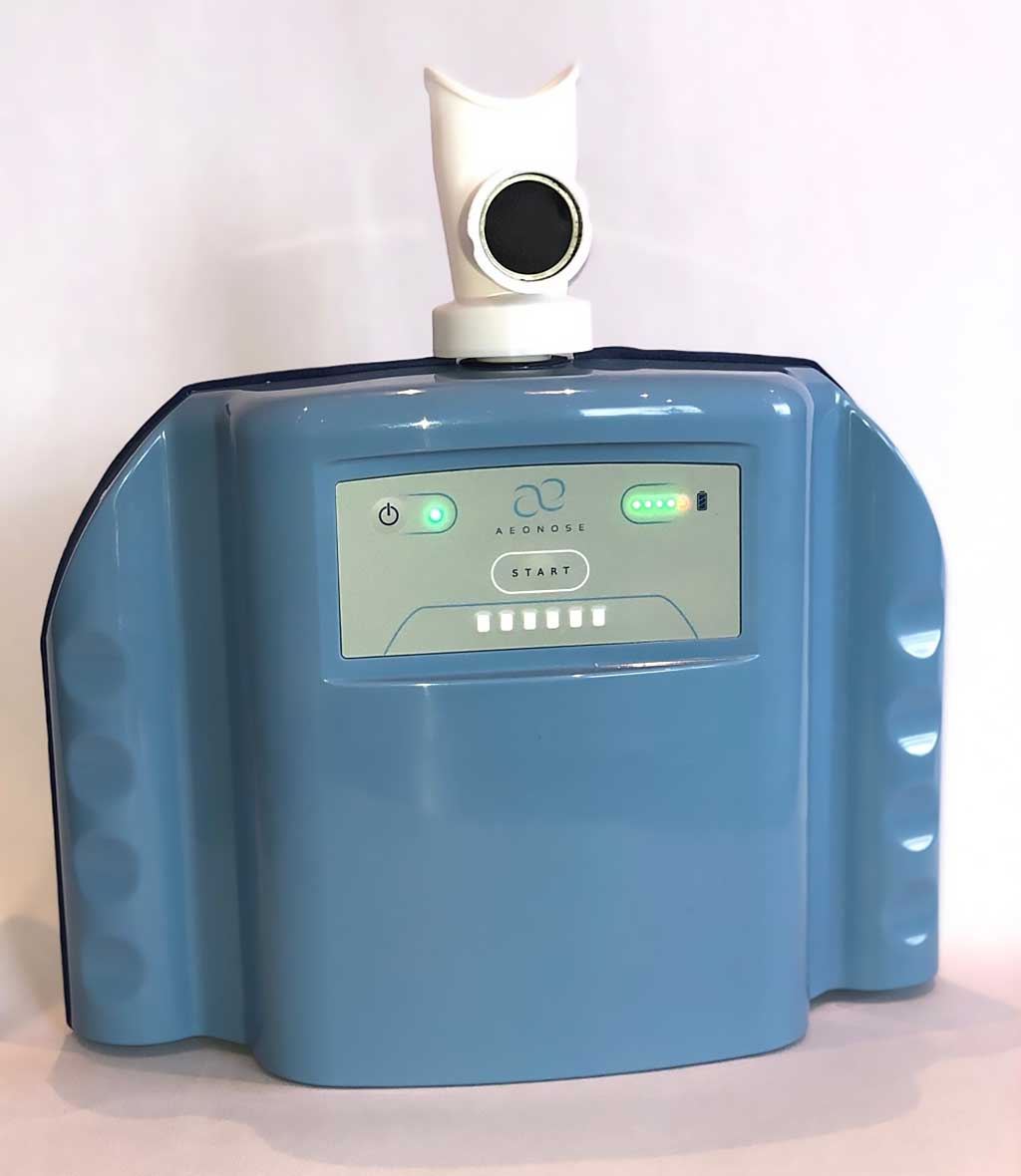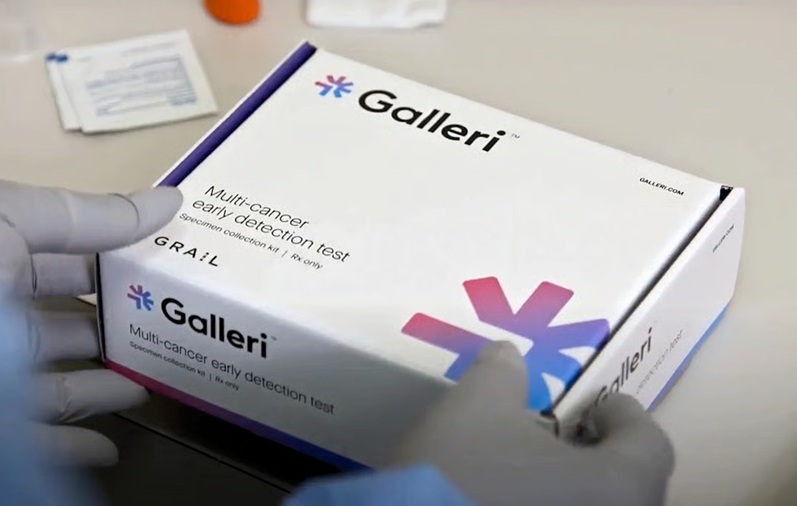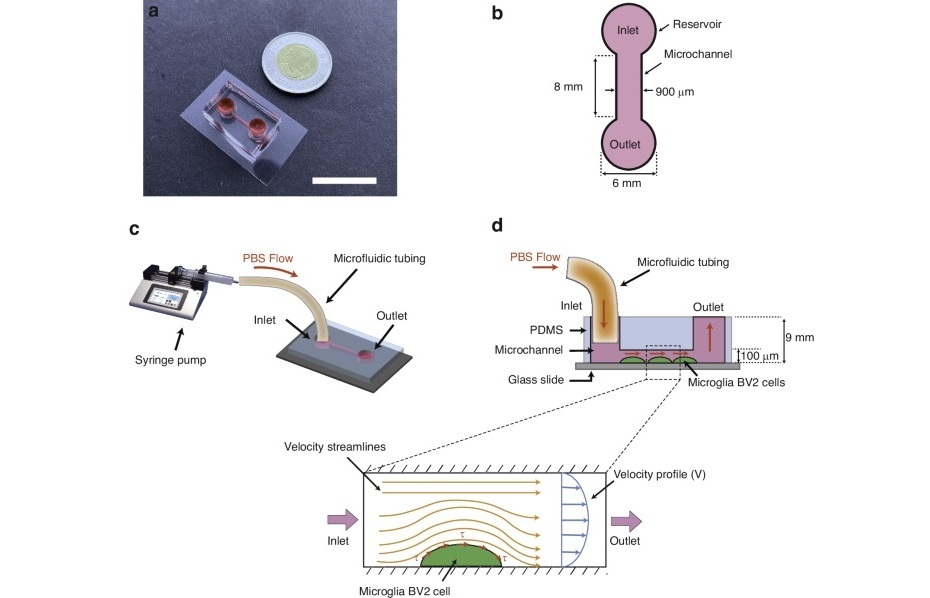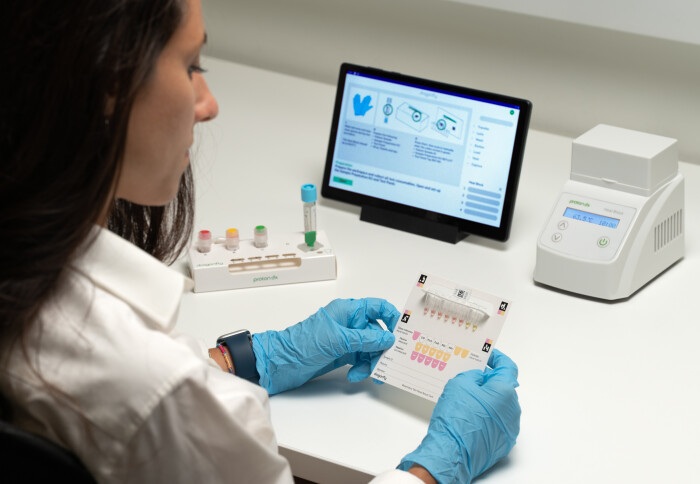Esophageal Cancer Precursor Detected by Electronic Nose Device
|
By LabMedica International staff writers Posted on 10 Mar 2020 |

Image: Electronic Nose Device Can Detect Esophageal Cancer Precursor (Photo courtesy of Radboud University Medical Center).
Barrett's esophagus is a condition in which the lining of the esophagus changes, becoming more like the lining of the small intestine rather than the esophagus. This occurs in the area where the esophagus is joined to the stomach.
The main cause of Barrett's esophagus is thought to be an adaptation to chronic acid exposure from reflux esophagitis. Barrett's esophagus is diagnosed by endoscopy: observing the characteristic appearance of this condition by direct inspection of the lower esophagus; followed by microscopic examination of tissue from the affected area obtained from biopsy.
Gastroenterologists at the Radboud University Medical Center (Nijmegen, the Netherlands) and their colleagues wanted to see how effective and accurate a portable 'electronic nose' device would be for picking up Barrett's esophagus. Some 402 adults scheduled for endoscopy breathed into a highly sensitive electronic nose, designed to detect subtle differences in volatile organic compounds (VOCs) patterns, for five minutes. Of this group, 129 patients had Barrett's esophagus; 141 had acid reflux disease, including 50 who had an inflamed esophagus as a result; and 132 had a normal esophagus or hiatus hernia that accounted for their symptoms.
Analysis of VOCs profiles detected by the electronic nose showed that these differed significantly among patients with Barrett's esophagus, acid reflux, and those with a normal esophagus/hernia. The sensitivity of the device was 91%, its ability to pick up Barrett's esophagus and its specificity was 74%, its ability to detect those without the condition. When the analysis was further restricted to patients who had been taking drugs (proton pump inhibitors) to curb stomach acid production for at least a month or those with a hiatus hernia, both of which are likely to muddy the diagnostic waters, its accuracy was still good.
The authors concluded that the technique analyzing VOCs with an electronic nose may enable an efficient, well-tolerated, and sensitive and specific screening method to select high-risk individuals to undergo upper endoscopy. The study was published on February 25, 2020 in the journal GUT.
Related Links:
Radboud University Medical Center
The main cause of Barrett's esophagus is thought to be an adaptation to chronic acid exposure from reflux esophagitis. Barrett's esophagus is diagnosed by endoscopy: observing the characteristic appearance of this condition by direct inspection of the lower esophagus; followed by microscopic examination of tissue from the affected area obtained from biopsy.
Gastroenterologists at the Radboud University Medical Center (Nijmegen, the Netherlands) and their colleagues wanted to see how effective and accurate a portable 'electronic nose' device would be for picking up Barrett's esophagus. Some 402 adults scheduled for endoscopy breathed into a highly sensitive electronic nose, designed to detect subtle differences in volatile organic compounds (VOCs) patterns, for five minutes. Of this group, 129 patients had Barrett's esophagus; 141 had acid reflux disease, including 50 who had an inflamed esophagus as a result; and 132 had a normal esophagus or hiatus hernia that accounted for their symptoms.
Analysis of VOCs profiles detected by the electronic nose showed that these differed significantly among patients with Barrett's esophagus, acid reflux, and those with a normal esophagus/hernia. The sensitivity of the device was 91%, its ability to pick up Barrett's esophagus and its specificity was 74%, its ability to detect those without the condition. When the analysis was further restricted to patients who had been taking drugs (proton pump inhibitors) to curb stomach acid production for at least a month or those with a hiatus hernia, both of which are likely to muddy the diagnostic waters, its accuracy was still good.
The authors concluded that the technique analyzing VOCs with an electronic nose may enable an efficient, well-tolerated, and sensitive and specific screening method to select high-risk individuals to undergo upper endoscopy. The study was published on February 25, 2020 in the journal GUT.
Related Links:
Radboud University Medical Center
Latest Technology News
- Acoustofluidic Device to Transform Point-Of-Care sEV-Based Diagnostics
- AI Algorithm Assesses Progressive Decline in Kidney Function
- Taste-Based Influenza Test Could Replace Nasal Swabs with Chewing Gum
- 3D Micro-Printed Sensors to Advance On-Chip Biosensing for Early Disease Detection
- Hybrid Pipette Combines Manual Control with Fast Electronic Aliquoting
- Coral-Inspired Capsule Samples Hidden Bacteria from Small Intestine
- Rapid Diagnostic Technology Utilizes Breath Samples to Detect Lower Respiratory Tract Infections
- Graphene-Based Sensor Uses Breath Sample to Identify Diabetes and Prediabetes in Minutes
- Wireless Sweat Patch Could Be Used as Diagnostic Test for Cystic Fibrosis
Channels
Clinical Chemistry
view channel
VOCs Show Promise for Early Multi-Cancer Detection
Early cancer detection is critical to improving survival rates, but most current screening methods focus on individual cancer types and often involve invasive procedures. This makes it difficult to identify... Read more
Portable Raman Spectroscopy Offers Cost-Effective Kidney Disease Diagnosis at POC
Kidney disease is typically diagnosed through blood or urine tests, often when patients present with symptoms such as blood in urine, shortness of breath, or weight loss. While these tests are common,... Read moreMolecular Diagnostics
view channel
Multi-Cancer Early Detection Blood Test Increases Cancer Detection
Cancer is the second leading cause of death worldwide as most deadly cancers are found too late. Approximately 70% of cancer deaths come from cancers that do not have standard-of-care screening and are... Read more
Portable Label-Free Device Tracks Alzheimer's Disease in Real Time
Alzheimer’s disease is marked by the accumulation of toxic protein fragments in the brain that damage nerve cells and impair memory. Detecting and tracking these early changes remains a major challenge,... Read moreHematology
view channel
Viscoelastic Testing Could Improve Treatment of Maternal Hemorrhage
Postpartum hemorrhage, severe bleeding after childbirth, remains one of the leading causes of maternal mortality worldwide, yet many of these deaths are preventable. Standard care can be hindered by delays... Read more
Pioneering Model Measures Radiation Exposure in Blood for Precise Cancer Treatments
Scientists have long focused on protecting organs near tumors during radiotherapy, but blood — a vital, circulating tissue — has largely been excluded from dose calculations. Each blood cell passing through... Read more
Platelets Could Improve Early and Minimally Invasive Detection of Cancer
Platelets are widely recognized for their role in blood clotting and scab formation, but they also play a crucial role in immune defense by detecting pathogens and recruiting immune cells.... Read more
Portable and Disposable Device Obtains Platelet-Rich Plasma Without Complex Equipment
Platelet-rich plasma (PRP) plays a crucial role in regenerative medicine due to its ability to accelerate healing and repair tissue. However, obtaining PRP traditionally requires expensive centrifugation... Read moreImmunology
view channel
Molecular Microscope Diagnostic System Assesses Lung Transplant Rejection
Lung transplant recipients face a significant risk of rejection and often require routine biopsies to monitor graft health, yet assessing the same biopsy sample can be highly inconsistent among pathologists.... Read more
Blood Test Tracks Treatment Resistance in High-Grade Serous Ovarian Cancer
High-grade serous ovarian cancer (HGSOC) is often diagnosed at an advanced stage because it spreads microscopically throughout the abdomen, and although initial surgery and chemotherapy can work, most... Read more
Luminescent Probe Measures Immune Cell Activity in Real Time
The human immune system plays a vital role in defending against disease, but its activity must be precisely monitored to ensure effective treatment in cancer therapy, autoimmune disorders, and organ transplants.... Read more
Blood-Based Immune Cell Signatures Could Guide Treatment Decisions for Critically Ill Patients
When a patient enters the emergency department in critical condition, clinicians must rapidly decide whether the patient has an infection, whether it is bacterial or viral, and whether immediate treatment... Read moreMicrobiology
view channel
Fast Noninvasive Bedside Test Uses Sugar Fingerprint to Detect Fungal Infections
Candida bloodstream infections are a growing global health threat, causing an estimated 6 million cases and 3.8 million deaths annually. Hospitals are particularly vulnerable, as weakened patients after... Read more
Rapid Sepsis Diagnostic Device to Enable Personalized Critical Care for ICU Patients
Sepsis is a life-threatening condition that occurs when the body’s response to infection spirals out of control, damaging organs and leading to critical illness. Patients often arrive at intensive care... Read morePathology
view channel
AI Improves Cervical Cancer Screening in Low-Resource Settings
Access to cervical cancer screening in low- and middle-income countries remains limited, leaving many women without early detection for this life-threatening disease. The lack of access to laboratories,... Read more
New Multi-Omics Tool Illuminates Cancer Progression
Tracking how cancers evolve into more aggressive and therapy-resistant forms has long been a challenge for researchers. Many current tools can only capture limited genetic information from tumor samples,... Read moreIndustry
view channel
Bio-Rad and Biodesix Partner to Develop Droplet Digital PCR High Complexity Assays
Bio-Rad Laboratories (Hercules, CA, USA) and Biodesix (Louisville, CO, USA) have expanded their partnership agreement under which Biodesix will conduct the development, clinical validation, and regulatory... Read moreHologic to be Acquired by Blackstone and TPG
Hologic (Marlborough, MA, USA) has entered into a definitive agreement to be acquired by funds managed by Blackstone (New York, NY, USA) and TPG (San Francisco, CA, USA) in a transaction valued at up to... Read more
Bio-Techne and Oxford Nanopore to Accelerate Development of Genetics Portfolio
Bio-Techne Corporation (Minneapolis, MN, USA) has expanded its agreement with Oxford Nanopore Technologies (Oxford, UK) to broaden Bio-Techne's ability to develop a portfolio of genetic products on Oxford... Read more







 Analyzer.jpg)








